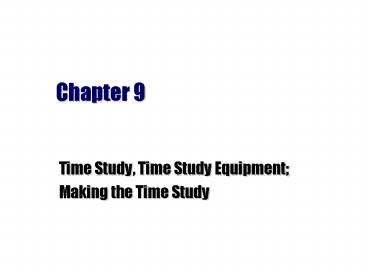Time Study, Time Study Equipment - PowerPoint PPT Presentation
1 / 35
Title:
Time Study, Time Study Equipment
Description:
Pocket Calculator. Videotape Equipment. Stop watch. Decimal minute watch (0.01 minute) ... Two watches are used in a manner whereby when the first is stopped, ... – PowerPoint PPT presentation
Number of Views:348
Avg rating:3.0/5.0
Title: Time Study, Time Study Equipment
1
Chapter 9
- Time Study, Time Study Equipment
- Making the Time Study
2
Time Study
- USED TO ESTABLISH TIME STANDARDS
- a FAIR DAYS WORK
- (3) ELEMENTS TO DETERMINE TIME STANDARDS
- ESTIMATES
- HISTORICAL RECORDS
- WORK MEASURMEMENT PROCEDURES
3
Four methods used for measuring work in industry
- Time study
- Pre-determined time standards
- Standard data
- Work sampling
4
A FAIR DAYS WORK
- Most people are unable to define it.
- Generally defined as
- Amount of work that can be produced by a
qualified employee when working at a standard
pace and effectively utilizing his time where
work is not restricted by process limitations. - Qualified employees, standard pace, effective
utilization?
5
STANDARD PACE
- The effective rate of performance of a
conscientious, self-paced, qualified employee
when working neither fast nor slow and giving
consideration to the physical, mental or visual
requirements of the specific job
6
Time Study Equipment
- Stopwatch
- Time Study Board
- Time Study Forms
- Pocket Calculator
- Videotape Equipment
7
Widely used Timing Devices
- Stop watch
- Decimal minute watch (0.01 minute)
- Figure 9-1, page 378
- Electronic timer
- Figure 9-2
8
Line of Sight
- The observer stands so that the work being
observed and the stop watch dial are along the
same line of sight.
9
Time study steps
- Record information on operation/operator
- Divide into elements record description
- Observe record time taken by operator
- Determine number of cycles to be timed
- Rate operator performance
- Verify number of cycles to be timed
- Determine allowances
- Compute standard time
10
Breaking it Down
- Keep manual and machine elements separate
- Separate constant elements from variable elements
- When an element is repeated, do not rewrite the
description again
11
Time study requests
- It is usually the supervisor who requests a time
study be conducted.
12
Time study
- Before beginning a time study, it is critical
that the observer determine if the job is really
ready for a time study.
13
Information
- We want to record as much information as
necessary so that someone totally unfamiliar with
the study could understand it.
14
Detailed description
- The time study will include a very detailed
description of the method that was used by the
operator.
15
Dividing Operations into Elements
- The element should be as short in duration as can
accurately be timed. - Handling time should be separated from machine
time. - Constant elements should be separated from
variable elements.
16
Stop watch methods
- Continuous timing
- Repetitive timing
- Accumulative timing
17
Continuous timing
- The analyst starts the stop watch at the
beginning of the first element and permits it to
run continuously during the period of the study.
18
Repetitive timing
- With this method, the hands of the watch are
snapped back to zero at the end of each element.
19
Accumulative timing
- Two watches are used in a manner whereby when the
first is stopped, the second is started and visa
- versa.
20
Number of cycles
- The greater the number of cycles timed, the more
nearly the results will be representative of the
activity being measured.
21
Rating
- In rating, it is up to the analyst to decide the
average level of performance at which the
operator was working while the study was being
made.
22
Allowances
- No operator can maintain a standard pace every
minute of every day. - There are (3) classes of interruptions that can
take place, for which extra time can take place. - Personal
- Fatigue
- Delay
23
Time value
- Unless a very good reason exists for deleting a
time value, it is left in.
24
Time Observation Data Sheet
25
- Time Observation Form Example
Task Time Is the value that repeats the most
Make sure to keep appropriately detailed notes
during time observations
If a time is missed, simply mark the box with the
letter m and keep going. Dont panic, and dont
stop the watch!
- Note that the times are cumulative
- keep the stop watch running
26
Chapter 10
- Time Study Determining the rating factor
27
Rating
- Perhaps the most important and most difficult
part of time study is to evaluate the speed or
tempo at which the person is working, termed
rating.
28
Rating
- Rating is a matter of judgement.
29
Performance Rating
- Performance Rating is the system of rating most
widely used today.
30
Range
- The range of most physical and mental activities
is 21 that is, the fastest operator will
produce twice as much as the slowest.
31
Incentive Earnings
- Most incentive earnings in this country fall
between 15 and 45, with the average being
around 25 - 35.
32
Skilled vs. Unskilled
- If a careful analysis were made of the operation,
it generally would be found that a skilled person
uses a different method from one used by a less
skilled worker.
33
Chapter 11
- Allowances
34
Allowances
- Personal
- Fatigue
- Delay
35
Environmental Conditions
- Work that is performed under adverse conditions
of heat and humidity and that involve heavy
physical exertion require a fatigue allowance.































